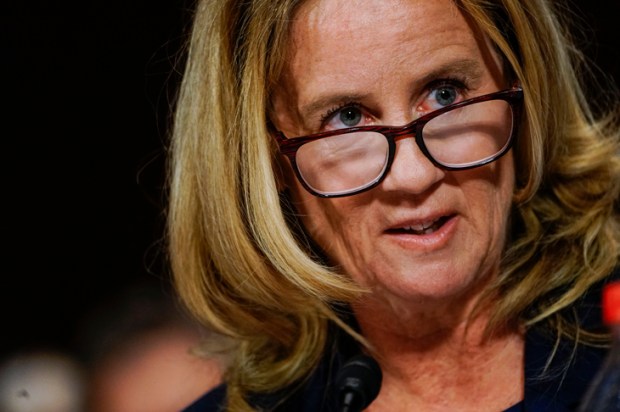The pressure group Women Against State Pension Inequality (Waspi) is oddly named. What their campaign opposes is pension equality.
Now, technically these activists born in the 1950s do not object to equalising the pension ages of men and women, so long as said activists don’t personally have to sacrifice for gender justice. Supposedly, the problem is insufficient notice.
Yet the UK bill to shift women’s state pension age from 60 to 65 was passed in 1995. That seems like pretty advance notice to me. Besides, government is not obliged to insure us against our expectations. The UK capriciously changes its tax policy every six months, and ‘but I didn’t expect a reduction of my capital gains allowance, so give me my money back’ doesn’t wash with HMRC. True, letters advising affected women that their pension age was changing didn’t go out until 2010, but the government wasn’t legallyobliged to send such letters ever. By 1995, the internet was taking off. For the past 25 years, a search on ‘women’s UK pension age’ has yielded enlightening results.
A little history: the first British state pension, the Old Age Pension, was introduced in 1909. It kicked in at age 70. It was means-tested. It paid 25p per week to those earning £21 per year or less, and tapered to nothing if one earned the princely annual sum of £31. (Obviously, given inflation, we’re not talking about Britons so impoverished that their entire annual income would only buy an immersion blender. I swoon with nostalgia for the days when the once-estimable pound was actually worth something.) Because life expectancy was then 48 for men and 55 for women, few made it into their 70s, and the pension cost the state mere bus fare.
In 1925, a contributory pension was introduced for over-65s. It was no longer means-tested. In order to draw the higher married rate, men older than their wives had to wait beyond the age of 65 — that is, until both spouses turned 65. To remedy this perceived injustice, in 1940 the pension age for women was lowered to 60, while men’s remained 65, to increase the likelihood that wedded men would be able to draw a full married-rate pension at 65. When the National Insurance system was introduced in 1948, the rules were merely tweaked: to draw a state pension, you had to retire.
Conservatives only passed that 1995 bill under pressure from the EU, which in this one glorious instance was not performing the role of Evil Incarnate. Because Tories were dependent on older voters, the bill put off gradually equalising men’s and women’s state pension ages until between 2010 and 2020 — a bracket of years so seemingly distant that they would clearly never arrive. By the time these dates became horribly real, David Cameron’s coalition was desperate to save money, and pushed the programme a tad: women’s pension age would equalise with men’s in 2018 rather than 2020, and then it would rise for both sexes to 66 in 2020 and to 67 in 2026. It’s currently slated to rise to 68 sometime between 2037 and 2039.
In sum, the state pension age of 65 for men and 60 for women remained perfectly unchanged for 70 solid years. In England and Wales, life expectancy in 1940 was 62 for men and 67 for women. By 2018, it was nearly 80 for men and 83 for women. On average, that’s 15 to 16 more years of state pension provision per capita, currently inflation-indexed and £168.60 per week: more than bus fare. And life expectancy continues to rise, with all the attendant NHS expenses, too.
Born in the latter 1950s, I belong to the Waspi cohort. I happen to be one of those fortunate people whose work is, on balance, a pleasure, even a privilege (in that bygone unpejorative sense of the word) — a luxury many don’t share. Much work is odious, and some jobs are physically taxing. It’s understandable that women who had expected to retire at 60, only to face five more years of what can be drudgery, are disappointed. But the disparity between the sexes’ pension ages was not designed for a world in which both sexes work, and hasn’t made sense for decades. It should have been equalised ages ago.
Compensating my cohort for losses due to this policy change would merely move the proverbial goalposts; the 1960s cohort would make the inaugural sacrifice instead. It would defeat the whole purpose of raising the pension age: to save the state, meaning us, money. Labour’s spontaneous pledge amidst the general election campaign to bribe Waspi women with an eye-popping £58 billion reimbursement (rewarding the likes of Diane Abbott with £23,000) constitutes not only gross fiscal irresponsibility, but naked vote-buying.
On Question Time, Boris Johnson was asked about Waspi compensation. Behold, a rare moment of political candour: er, uh, gosh, um… it’s too expensive. Defending Labour’s contrasting promise of a lavish Waspi backhander the following week, Andy McDonald declared sanctimoniously that this is a ‘moral’ issue. He was right, but not in the manner he meant.
We cannot retire at 60, and we shouldn’t be retiring at 65 or 66. The speed at which the UK pension age is rising is ruinously slow, and I’d put money on it going up to 68 well before 2037. Life expectancy is only an average, and includes early mortality, leaving many of the rest of us to live to 90, even 100. That means those train drivers in France who insist on retiring at 52 expect the state — a euphemism for ‘other people’ — to carry them for up to 50 years, decades longer than they worked.
This is indeed a moral issue. State pensions are financed by younger people with jobs. Today’s graduates will toil on my generation’s behalf. Expecting them to pay draconian taxes to keep my lot in tea and biscuits isn’t fair. Folks my age are going to have to keep working until at least 70, if not 75. So you’d better like these columns.
Got something to add? Join the discussion and comment below.
Get 10 issues for just $10
Subscribe to The Spectator Australia today for the next 10 magazine issues, plus full online access, for just $10.
You might disagree with half of it, but you’ll enjoy reading all of it. Try your first month for free, then just $2 a week for the remainder of your first year.















Comments
Don't miss out
Join the conversation with other Spectator Australia readers. Subscribe to leave a comment.
SUBSCRIBEAlready a subscriber? Log in